Hydrangea, commonly named the hortensia, is a genus of more than 70 species of flowering plants native to Asia and the Americas. By far the greatest species diversity is in eastern Asia, notably China, Korea, and Japan.
The majority of hydrangeas are bushy or shrubs in nature, ranging from 1 to 3 meters (3 feet 3 inches to 9 feet 10 inches) in height. A few are diminutive trees and some climbing as lianas, reaching heights of up to 30 meters (100 feet) by scaling trees.
Hydrangeas also exhibit both deciduous and evergreen characteristics, although the well-known temperate varieties that are extensively cultivated are uniformly deciduous.
Hydrangea blossoms emerge from early spring to late autumn, appearing in the form of flowerheads, usually corymbs or panicles, most often at the ends of the stems. These flowerheads comprise two flower types: inconspicuous, small fertile flowers positioned in the center or inner part of the flowerhead and large colored sepals (tepals) surrounding them.
These flowers are arranged in a ring-like fashion or located on the outer perimeter of the small flowers. In their natural habitats, wild hydrangea populations usually have few, if any, of showy flowers, whereas cultivated hydrangea varieties that have been selectively bred feature an abundance of larger, more conspicuous blooms.
The color of hydrangea flowers can be different because of soil pH. In acidic soils, they tend to be blue or purple, while in alkaline soils, they tend to be pink or red. Some varieties can change color as they age.
List of Hydrangeas
- Bigleaf Hydrangea – Hydrangea macrophylla
- Oakleaf Hydrangea – Hydrangea quercifolia
- Smooth Hydrangea – Hydrangea arborescens
- Panicle Hydrangea – Hydrangea paniculata
- Mountain Hydrangea – Hydrangea serrata
- Climbing Hydrangea – Hydrangea petiolaris
- Hydrangea involucrata – Hydrangea involucrata
- Sargent’s Hydrangea – Hydrangea sargentiana
- Silverleaf hydrangea – Hydrangea radiate
- Chinese hydrangea vine- Hydrangea chinensis
- Hydrangea cinerea, the ashy hydrangea
- Himalayan hydrangea Hydrangea heteromalla
Bigleaf Hydrangea – Hydrangea macrophylla
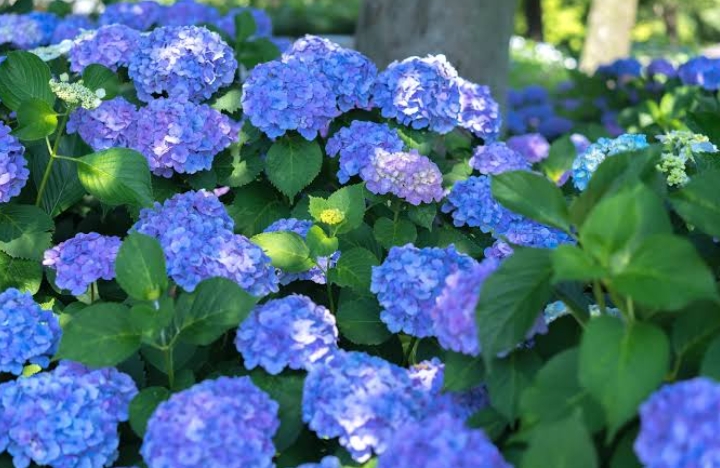
Bigleaf Hydrangea is a deciduous in nature and is native to East Asia. It is reportedly from seaside habitats as well as mountains in Japan. It grows to a height of about 3 to 6 feet (0.9 to 1.8 meters).
It produces beautiful, globe-shaped flower clusters called “mophead” or “lacecap” inflorescences. Mophead varieties have dense, round clusters of flowers, while lacecap varieties have a flat-topped appearance with smaller fertile flowers surrounded by larger sterile ones.
These clusters of flowers can change color depending on soil pH. The flower clusters, can be blue, pink, or purple in color. Flowering begins in late spring and lasts until early winter.
It usually blooms on the previous year’s growth, often described as “old wood.” Some cultivars are classified as reblooming, bloom again, later in the summer, on new growth.
Common names include bigleaf hydrangea, French hydrangea, lacecap hydrangea and mophead hydrangea.
Cultivars
| Cultivar Name | Flower Color | Size |
| ‘All Summer Beauty’ | Blue or pink | 4-6 ft. |
| ‘Ayesha’ | Blue or pink | 4-6 ft. |
| ‘Endless Summer Bloomstruck’ | Blue or pink | 3-4 ft. |
| ‘Endless Summer Original’ | Blue or pink | 3-5 ft. |
| ‘Endless Summer Twist-n-Shout’ | Blue or pink | 3-4 ft. |
| ‘Lady in Red’ | Blue or pink | 3-4 ft. |
| ‘Light-O-Day’ | Blue or pink | 3-4 ft. |
| ‘Masja’ | Blue or pink | 3-4 ft. |
| ‘Penny Mac’ | Blue or pink | 3-5 ft. |
| ‘Pia’ | Blue or pink | 3-5 ft. |
| ‘Sister Theresa’ | Blue or pink | 3-4 ft. |
| ‘Teller White’ | White | 3-4 ft. |
| ‘Todi’ | Blue or pink | 3-4 ft. |
Oakleaf Hydrangea – Hydrangea quercifolia
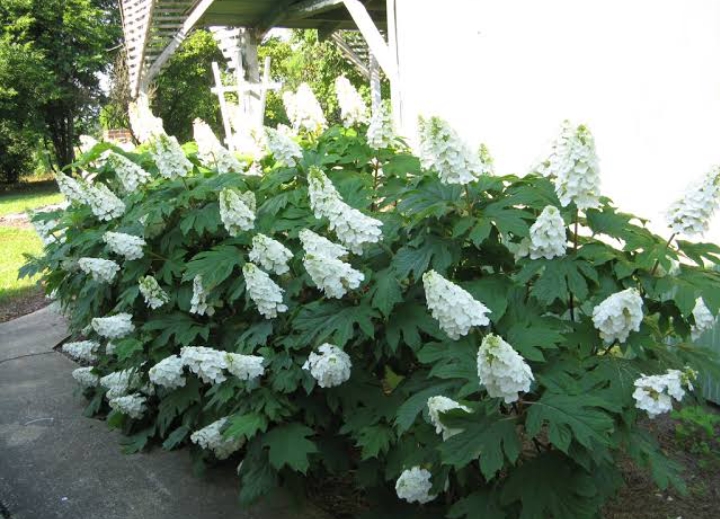
Oakleaf Hydrangea is deciduous and grow to be quite large, up to 6 to 8 feet in height. It is native to the southeastern United States, in woodland habitats from North Carolina west to Tennessee, and south to Florida and Louisiana.
Its name, “oakleaf,” come from the shape of its leaves, which resemble those of oak trees. The leave is deeply lobed with toothed margins. The leaves also turn vibrant shades of red, orange, and purple in the fall.
It has large, cone-shaped clusters of white or pale pink, showy flowers that appear in late spring to early summer. These flowers can reach up to 10 inches in length. As they age, the flowers usually turn a pale, papery brown. The bark on branches and stem is exfoliating.
Like the panicle hydrangea, its flowers develop pinkish undertones as they mature. The oakleaf hydrangea is considered hardy to USDA Hardiness Zone 5.
Cultivars
| Cultivar Name | Flower Color | Size |
| ‘Alice’ | White, turning pink | 8-12 ft |
| ‘Harmony’ | White, turning pink | 6-8 ft |
| ‘Snow Queen’ | White, turning pink | 4-6 ft |
| ‘Ruby Slippers’ | White, turning pink | 3-5 ft |
| ‘Sikes Dwarf’ | White, turning pink | 3-4 ft |
| ‘Pee Wee’ | White, turning pink | 3-4 ft |
| ‘Gatsby Gal’ | White, turning pink | 4-6 ft |
| ‘Gatsby Pink’ | White, turning pink | 6-8 ft |
| ‘Munchkin’ | White, turning pink | 3-4 ft |
| ‘Little Honey’ | White, turning pink | 3-4 ft |
| ‘Amethyst’ | White, turning pink | 6 ft |
| ‘Jet Stream’ | White, turning pink | 6 ft |
Smooth Hydrangea – Hydrangea arborescens
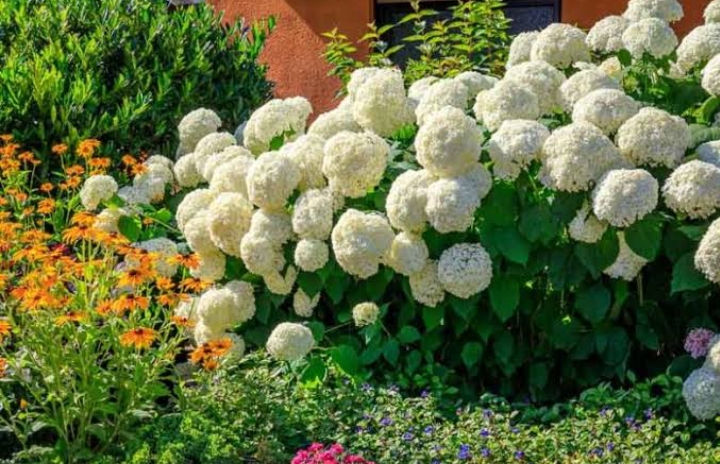
Hydrangea arborescens, commonly known as smooth hydrangea, wild hydrangea, sevenbark, or in some cases, sheep flower, is a multi-stemmed, shrub up to 2 m tall. It is native to the eastern United States.
Unlike some other hydrangea species, the flower color is not influenced by soil pH. The blooms emerge as creamy white and gradually transition to a shade of pale green as they mature. Over time, they may turn a light tan or brown.
This cultivar can be spotted from a great distance. The flowers are so heavy, that they weigh the stems to the ground giving the shrub a “weeping effect”.
The stem bark has a peculiar tendency to peel off in several successive thin layers with different colors, hence the common name “sevenbark”. It can spread rapidly by stolons to form colonies.
It is a hardy and resilient plant, able to withstand cold winters and maintain its charm throughout the seasons. It is common in the Delaware River Valley and in the Appalachian Mountains. It is a host plant of the hydrangea sphinx moth.
Cultivars
| Cultivar Name | Flower Color | Size |
| ‘Annabelle’ | White, turning green | 3-5 ft |
| ‘Incrediball’ | White | 4-5 ft |
| ‘Invincibelle Spirit’ | Pink | 3-4 ft |
| ‘Hayes Starburst’ | White | 3-5 ft |
| ‘White Dome’ | White | 4-6 ft |
| ‘Abetwo’ | White | 4-5 ft |
| ‘Grandiflora’ | White | 3-5 ft |
| ‘Pink Sensation’ | Pink | 3-5 ft |
| ‘Emerald Lace’ | White | 4-6 ft |
| ‘White Diamonds’ | White | 3-5 ft |
| ‘Bounty’ | White | 3-5 ft |
| ‘Strong Annabelle’ | White | 4-5 ft |
Panicle Hydrangea – Hydrangea paniculata
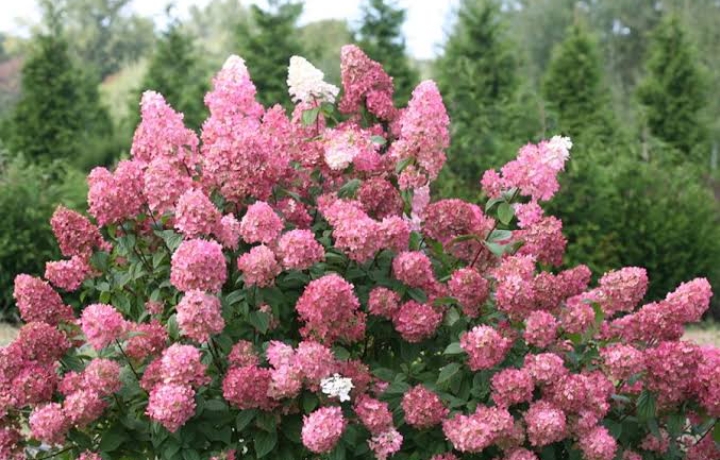
Hydrangea paniculata also referred to as panicled hydrangea, was first formally described by Philipp Franz von Siebold in 1829. It is native to southern and eastern China, Korea, Japan and Russia.
It is small tree is small in size (3.3–16.4 ft) growing in sparse forests or thickets in valleys or on mountain slopes.
In late summer it bears large conical panicles of creamy white fertile flowers, together with pinkish-white sterile florets. Florets may open pale green, grading to white with age, sometimes creating what is called by florists as “two-tone” effect.
The main features of Panicle Hydrangea is its large flower heads. Can be pure white or in shades of pink, red, or even green, depending on the cultivar and the stage of bloom. These panicles can be quite long and may extend up to 18 inches. The bloom period usually begins in mid-summer and extends into early autumn.
It can grow in USDA zones 3-8. It’s also one of the few hydrangeas that bloom on new wood, which means it’s less susceptible to winter damage and can be pruned in the late winter or early spring without affecting its flowering.
Cultivars
| Cultivar Name | Flower Color | Size |
| ‘Limelight’ | Greenish-white, turning pink | 6-8 ft |
| ‘Pinky Winky’ | White, turning pink | 6-8 ft |
| ‘Quick Fire’ | White, turning pink | 6-8 ft |
| ‘Little Quick Fire’ | White, turning pink | 3-5 ft |
| ‘Bobo’ | White, turning pink | 3-4 ft |
| ‘Grandiflora’ | White, turning pink | 6-8 ft |
| ‘Tardiva’ | White, turning pink | 6-8 ft |
| ‘Phantom’ | White, turning pink | 6-8 ft |
| ‘Pee Wee’ | White, turning pink | 3-5 ft |
| ‘Pink Diamond’ | White, turning pink | 6-8 ft |
| ‘Praecox’ | White, turning pink | 6-8 ft |
| ‘Unique’ | White, turning pink | 6-8 ft |
| ‘White Moth’ | White, turning pink | 6-8 ft |
| ‘Strawberry Sundae’ | White, turning pink | 4-6 ft |
Mountain Hydrangea – Hydrangea serrata
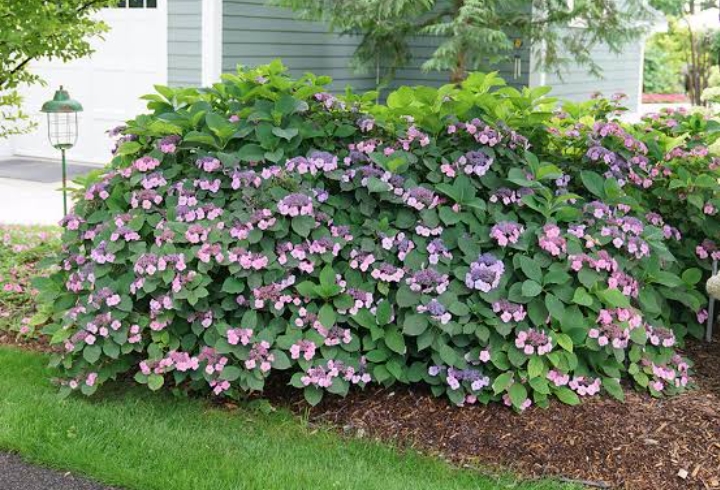
Hydrangea serrata is native to mountainous regions of Korea and Japan. Common names include mountain hydrangea and tea of heaven.
Hydrangea serrata grows to a height of 2-4 feet and has a similar spread. It thrives in USDA hardiness zones 6-9.
The leaves are ovate and serrated, with a dark green color. They grow to be 2-6 inches long. The flowers bloom in the summer and can last until early fall.
The flowerheads are composed of two types of flowers: large, showy sterile florets that form a ring around the outside, and small, fertile florets in the center. The sterile florets can be blue or pink, depending on the acidity of the soil.
It is winter hardy to USDA Zone 6, and it can be grown in USDA Zone 5 with protection (e.g., mulch and burlap wrap). It may lose significant numbers of flower buds or die to the ground in harsh winters, impairing or decimating the bloom for the coming year.
Plants are hardy to about −13 °F (−25 °C) when dormant, but the young growth in spring can be killed by late frosts.
Cultivars
| Cultivar Name | Flower Color | Size |
| ‘Bluebird’ | Blue | 2-3 ft. tall |
| ‘Diadem’ | Pink or blue | 3-4 ft. tall |
| ‘Grayswood’ | Blue or pink | 3-4 ft. tall |
| ‘Kiyosumi’ | Blue or pink | 3-4 ft. tall |
| ‘Miranda’ | Blue or pink | 3-4 ft. tall |
| ‘Miyama-yae-murasaki’ | Blue or pink | 3-4 ft. tall |
| ‘Preziosa’ | Blue or pink | 3-4 ft. tall |
| ‘Rosalba’ | White | 3-4 ft. tall |
| ‘Shirofuji’ | White | 3-4 ft. tall |
| ‘Shojo’ | Pink or blue | 3-4 ft. tall |
| ‘Tiara’ | Blue or pink | 3-4 ft. tall |
Climbing Hydrangea – Hydrangea petiolaris
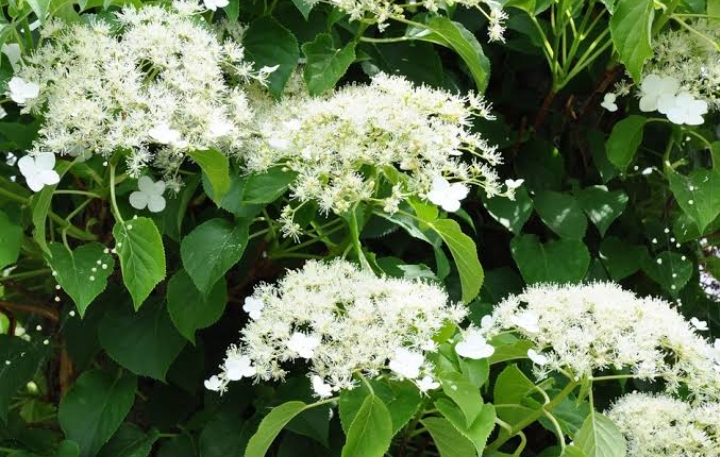
Hydrangea petiolaris, also known as the climbing hydrangea or the petioled hydrangea, is a deciduous, woody vine that is native to the woodlands of Japan, the Korean peninsula, and on Sakhalin island of easternmost Siberia in the Russian Far East.
It can grow up to 50 feet tall with its growth rate being relatively slow, averaging about 6-12 inches per year. The plant features dark green leaves. The leaves turn golden yellow in the fall before dropping for the winter.
It features large, white, lacecap-like flowers, which bloom in late spring to early summer. These blooms are composed of a central cluster of tiny, fertile flowers surrounded by larger, sterile flowers. The flowers are also slightly fragrant in nature.
Climbing hydrangeas are hardy in USDA zones 4-8. It can resist temperatures down to between -34.4 °C (-30 °F) and -31.7 °C (-25 °F). It prefers partial shade to full shade, although they can tolerate some sun if provided with adequate moisture.
It is usually grown either on masonry walls or on sturdy trellises or fences. It is at its best where it gets morning sun and afternoon shade. It can also be grown as a ground cover.
The young leaves of climbing hydrangea are edible when cooked. Tasting like cucumber, they’re sometimes added to Miso in Japan.
Cultivars
| Cultivar Name | Flower Color | Size |
| Hydrangea petiolaris (species) | White | 30-50 ft. tall |
| ‘Sutert’ (Skylands Giant) | White | 30-50 ft. tall |
| ‘Aurea’ | White | 30-50 ft. tall |
| ‘Miranda’ | White | 30-50 ft. tall |
| ‘Silver Lining’ | White | 30-50 ft. tall |
| ‘Flying Saucer’ | White | 30-50 ft. tall |
| ‘Kuga Variegated’ | White | 30-50 ft. tall |
| ‘Furuaziai’ | White | 30-50 ft. tall |
| ‘Kasai’ | White | 30-50 ft. tall |
Hydrangea involucrata – Hydrangea involucrata
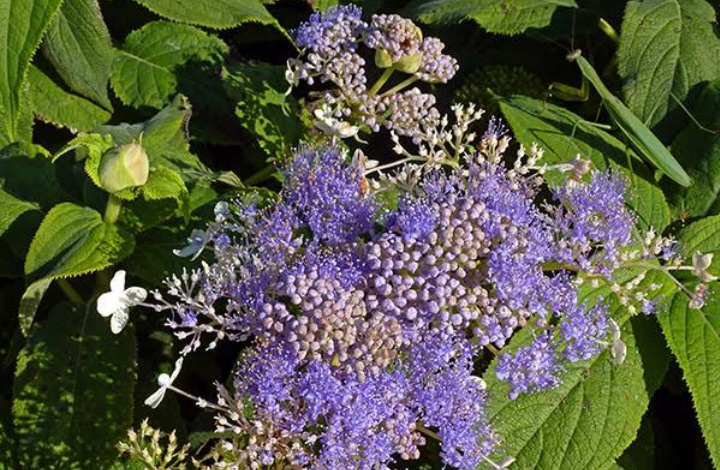
Hydrangea involucrata, commonly known as the Japanese hydrangea or the Japanese snowball, is a deciduous shrub native to Japan and Taiwan.
The plant grows to a height of 3-6 feet. The leaves are dark green in color.
The flowers bloom in the summer and can last until early fall. The flowerheads are composed of small, fertile flowers surrounded by larger, sterile flowers. The sterile flowers are white in color and can be up to 2 inches in diameter.
Cultivars
| Cultivar Name | Flower Color | Size |
| ‘Aureola’ | White, turning pink | 15 feet |
| ‘Miyama-yae-murasaki’ | White, turning pink | 18 feet |
| ‘Pistachio’ | White, turning pink | 16 feet |
| ‘Plena’ | White, turning pink | 20 feet |
| ‘Shibori’ | White, turning pink | 14 feet |
| ‘Moonlight‘ | White, turning pink | 20 feet |
Sargent’s Hydrangea, or Hydrangea sargentiana
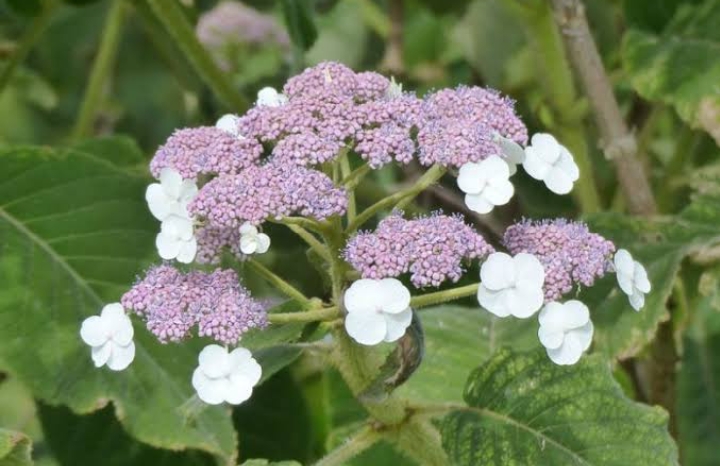
Sargent’s Hydrangea, or Hydrangea sargentiana, is native to western China and is named after Charles Sprague Sargent, a prominent American botanist and the first director of the Arnold Arboretum at Harvard University.
It grows up to 6-12 feet tall. It has a bushy and upright growth habit, with stout, hairy branches. The leaves are large and have a dull green color with a hairy texture on the upper side.
The flowers are borne in large nearly flat cymes that are about 5 inches in diameter. The central flowers are fertile and have a blue or purple color, while the surrounding flowers are sterile and have a white color.
The flowers bloom in the summer and are followed by small, dry, and inconspicuous fruits.
Silverleaf Hydrangea, or Hydrangea radiata
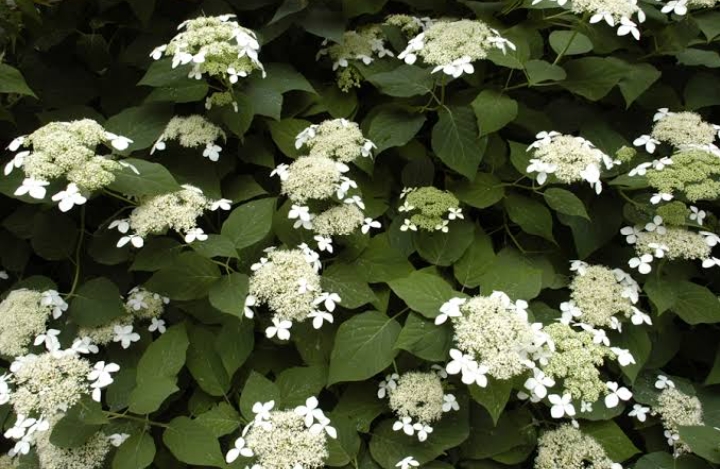
Silverleaf Hydrangea, or Hydrangea radiata, is native to the southern Appalachian Mountains in the southeastern United States. Its foliage is dark green on top and silvery white underneath, thus the common name “silverleaf.”
The plant grows to a height of 3-6 feet and has a rounded crown with many unbranched stems. It prefers partial shade and moist, well-drained, acidic soil.
This hydrangea produces white flowers in clusters that are 3-6 inches wide. The flowers bloom in late spring to early summer.
The plant works well for woodland gardens, native plant gardens, and naturalized areas. It can be used in a mass planting or as a specimen plant.
Chinese hydrangea vine- Hydrangea chinensis
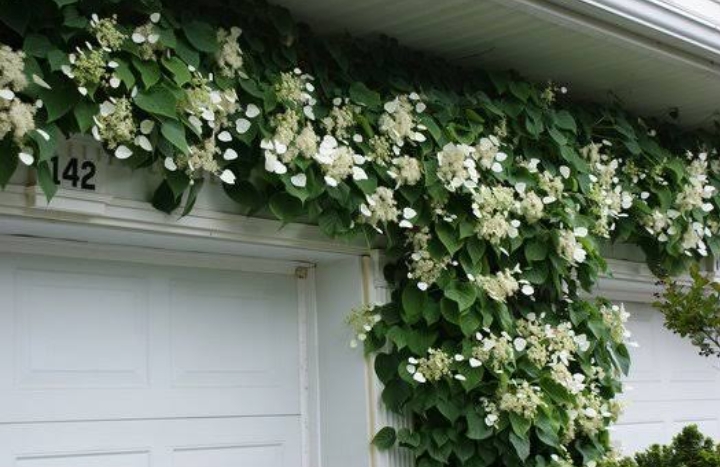
The Chinese Hydrangea Vine, scientifically known Hydrangea chinensis or Hydrangea glaucescens is a deciduous climbing hydrangea native to China. It is a vigorous climber and can grow up to 15 feet in height.
The leaves are of glossy green color. The plant produces clusters of small, white flowers in the summer, which can be either fertile or sterile. The fertile flowers are small and inconspicuous, while the sterile flowers are larger.
It can be grown in gardens, where it can be trained to climb walls, fences, or trellises. It can also be grown in containers or used as a ground cover.
Hydrangea cinerea, the ashy hydrangea
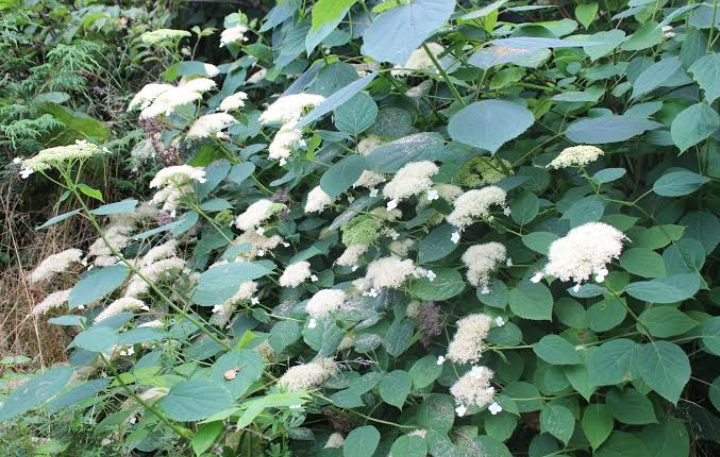
Hydrangea cinerea, commonly known as the ashy hydrangea or gray hydrangea, is native to the interior regions of the southeastern United States. Its natural range extends from Tennessee to South Carolina, west to Missouri, and south to Arkansas, Alabama, and Georgia.
The common names “ashy” and “gray” refer to the ashy or gray appearance of the undersides of its leaves, which results from a dense pubescence. The plant grows in neutral, basic, or calcareous soils and is usually found in rocky outcrops and upland sites.
The inflorescence of ashy hydrangea is a corymb, with sterile flowers (white to near white) that are usually greater than 1 cm in diameter. These flowers are few (0–3 per flowerhead) and are borne around the periphery of the corymb. Flowering occurs in late spring or early summer.
Himalayan hydrangea Hydrangea heteromalla
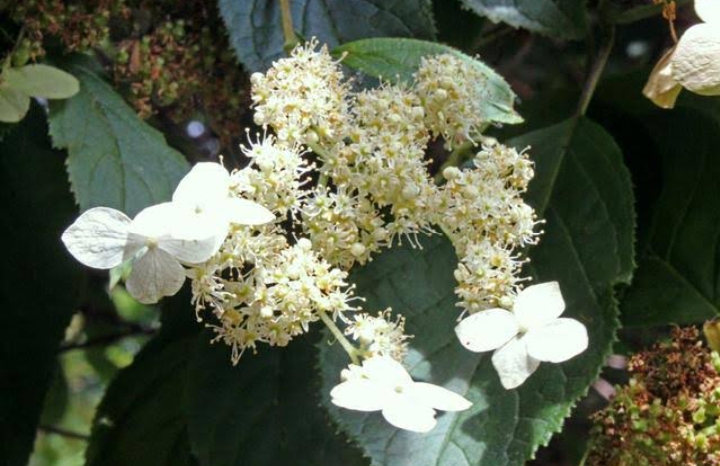
Himalayan hydrangea, also referred to as Hydrangea heteromalla, is native to the Himalayas and China. It is also commonly called woolly hydrangea. The plant grows in alpine forests and thickets in its natural habitat.
It produces large, conical blooms that can be up to 30 cm long and 20 cm wide. The flowers are white and bloom in the summer months, that’s from May to June.
It is hardy in USDA zones 7-9 and can grow in full sun to partial shade. It is not particularly drought tolerant and requires regular watering to thrive.